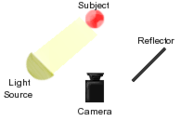
Rembrandt lighting
Encyclopedia

Lighting
Lighting or illumination is the deliberate application of light to achieve some practical or aesthetic effect. Lighting includes the use of both artificial light sources such as lamps and light fixtures, as well as natural illumination by capturing daylight...
technique that is sometimes used in studio portrait photography
Photography
Photography is the art, science and practice of creating durable images by recording light or other electromagnetic radiation, either electronically by means of an image sensor or chemically by means of a light-sensitive material such as photographic film...
. It can be achieved using one light and a reflector, or two lights, and is popular because it is capable of producing images which appear both natural and compelling with a minimum of equipment. Rembrandt lighting is characterized by an illuminated triangle under the eye of the subject, on the less illuminated side of the face. It is named for the Dutch painter Rembrandt, who often used this type of lighting.
Description
Normally, the key lightKey light
The key light is the first and usually most important light that a photographer, cinematographer, lighting cameraman, or other scene composer will use in a lighting setup. The purpose of the key light is to highlight the form and dimension of the subject. The key light is not a rigid requirement;...
is placed high and to one side at the front, and the fill light
Fill light
In television, film, stage, or photographic lighting, a fill light may be used to reduce the contrast of a scene and provide some illumination for the areas of the image that are in shadow...
or a reflector is placed half-height and on the other side at the front, set to about half the power of the key light, with the subject, if facing at an angle to the camera, with the key light
Key light
The key light is the first and usually most important light that a photographer, cinematographer, lighting cameraman, or other scene composer will use in a lighting setup. The purpose of the key light is to highlight the form and dimension of the subject. The key light is not a rigid requirement;...
illuminating the far side of the face.
The key in Rembrandt lighting is creating the triangle or diamond shape of light underneath the eye. One side of the face is lit well from the main light source while the other side of the face uses the interaction of shadows and light, also known as chiaroscuro
Chiaroscuro
Chiaroscuro in art is "an Italian term which literally means 'light-dark'. In paintings the description refers to clear tonal contrasts which are often used to suggest the volume and modelling of the subjects depicted"....
, to create this geometric form on the face.
The triangle should be no longer than the nose and no wider than the eye. This technique may be achieved subtly or very dramatically by altering the distance between subject and lights and relative strengths of main and fill lights.
It is a common photography technique.
Origin of photographic term
Pioneering movie director Cecil B. DeMilleCecil B. DeMille
Cecil Blount DeMille was an American film director and Academy Award-winning film producer in both silent and sound films. He was renowned for the flamboyance and showmanship of his movies...
is credited with the first use of the term:
DeMille explained in his autobiography that while shooting THE WARRENS OF VIRGINIA (1915), he borrowed some portable spotlights from the Mason Opera House in downtown Los Angeles and “began to make shadows where shadows would appear in nature.” When business partner Sam Goldwyn saw the film with only half an actor’s face illuminated, he feared the exhibitors would pay only half the price for the picture. After DeMille told him it was Rembrandt lighting, “Sam’s reply was jubilant with relief: for Rembrandt lighting the exhibitors would pay double!”

